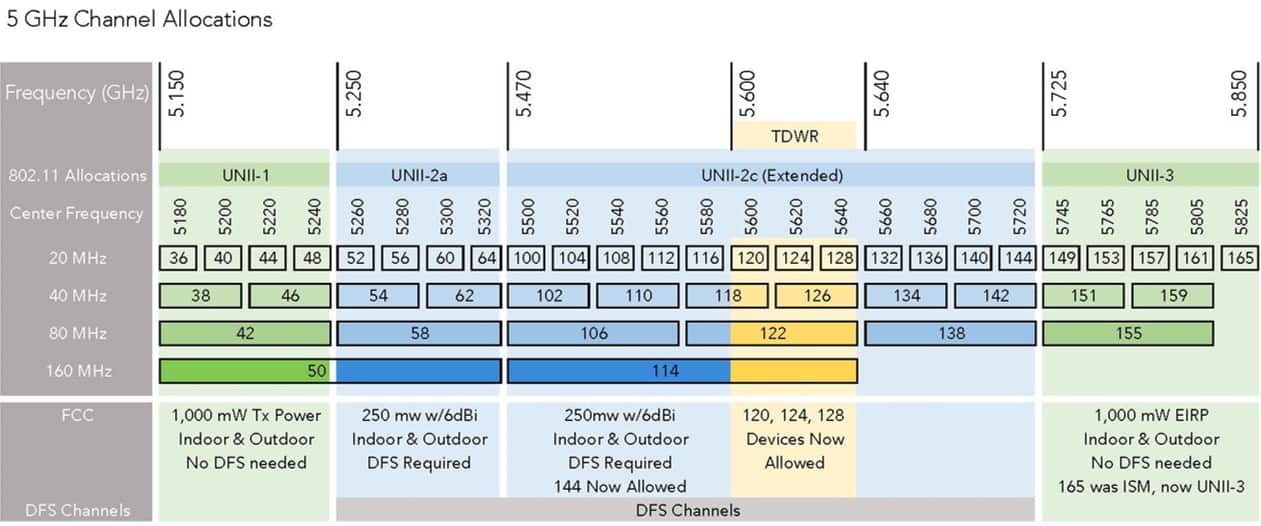can we have a list of triple+ wifi interface routers supported by openwrt?
these devices should have 3 full-featured interfaces, not 2 plus some crippled slow interface for DFS compliance.
help me build it! i'll start...
--------------- 2.4 / 5 GHz ---------------
Qualcomm IPQ4019 (4x ARM Cortex-A7 @ 717 MHz)
Linksys WHW03 V2
Flash 512 MB, RAM 512 MB.
https://openwrt.org/toh/linksys/whw03_v2
two 5 GHz radios with very limited channel support and no DFS.
channels (23.05.3 and previous builds):
- 32: unsupported
- 36 ~ 48: supported
- 52 ~ 68: unsupported
- 96 ~ 144: unsupported
- 149 ~ 165: supported
- 169 ~ 177: unsupported
EDIT: it seems that these devices should support the same channel ranges as the EA/MR8300 and that the restricted channel support is the result of a bug in the official openwrt port. i will try getting one of these devices to debug channel support.
EDIT: got the device and fixed the issue. the changes were accepted into the master and 23.05 branches, so all builds after 23.05.3 will support the usual channel ranges for these architecture.
channels (builds newer than and excluding 23.05.3):
- 32: unsupported
- 36 ~ 64: supported
- 68: unsupported
- 96: unsupported
- 100 ~ 165: supported
- 169 ~ 177: unsupported
Linksys EA8300 and MR8300
Flash 256 MB, RAM 256 MB.
https://openwrt.org/toh/linksys/ea8300
https://openwrt.org/toh/linksys/mr8300
Note: EA8250 and MR8250 seem to be versions of the routers above using the same hardware but with 256QAM modulation disabled by software.
two 5 GHz radios:
- 32: unsupported
- 36 ~ 64: supported
- 68: unsupported
- 96: unsupported
- 100 ~ 165: supported
- 169 ~ 177: unsupported
ASUS Lyra (MAP-AC2200)
Flash 128 MB, RAM 256 MB.
https://openwrt.org/toh/asus/lyra_map-ac2200
two 5 GHz radios:
- 32: unsupported
- 36 ~ 64: supported
- 68: unsupported
- 96: unsupported
- 100 ~ 140: supported
- 144 ~ 165: conflicting info (please help clarify)
- 169 ~ 177: unsupported
NETGEAR RBR50 / RBS50
Flash 4 GB, RAM 512 MB.
https://openwrt.org/toh/hwdata/netgear/netgear_rbr50
https://openwrt.org/toh/hwdata/netgear/netgear_rbs50
GL.iNet GL-B2200
Flash 16 MB SPI + 8 GB eMMC, RAM 512 MB.
https://openwrt.org/toh/gl.inet/gl-b2200
two 5 GHz radios, channel support unknown. (help me!)
NETGEAR SRR60 / SRS60
Flash 4 GB, RAM 512 MB.
https://openwrt.org/toh/hwdata/netgear/netgear_srr60
https://openwrt.org/toh/hwdata/netgear/netgear_srs60
MediaTek MT7621AT (2x MIPS 24KC @ 880 MHz)
D-Link DIR-3060 A1
Flash 128 MB, RAM 256 MB.
https://openwrt.org/toh/d-link/dir-3060_a1
two 5 GHz radios, channel support unknown. (help me!)
Qualcomm IPQ8174 (4x ARM Cortex-A53 @ 1400 MHz)
Linksys Linksys MX4200 V1 and V2
Flash 512 MB, RAM 512 GB.
https://git.openwrt.org/?p=openwrt/openwrt.git;a=commit;h=46a2490e8f24a1ad47e53b0b4ee875fa3658f2c1
radios:
- 5 GHz AX 2x2@80MHz / 2x2@160MHz channels ???
- 5 GHz AX 4x4@80MHz / 2x2@160MHz channels ???
- 2.4 GHz AX 2x2
Qualcomm IPQ8072A (4x ARM Cortex-A53 @ 2200 MHz)
Linksys MX5300
Flash 512 MB, RAM 1 GB.
https://git.openwrt.org/?p=openwrt/openwrt.git;a=commit;h=70fd815e57dc98cef88828faa5ce71717540e99e
radios:
- 5 GHz AC 4x4 channels 100 ~ 169
- 5 GHz AX 4x4 channels 36 ~ 64
- 2.4 GHz AX 4x4
Xiaomi Mi Router AX9000
Flash 256 MB, RAM 1 GB.
https://openwrt.org/toh/xiaomi/ax9000
radios:
- one 2.4 GHz (QCN9024 4×4 ax)
- two 5 GHz (QCN5024 4×4 ax + QCN9024 2×2/4×4 ax)
- one AIoT (QCA9889 1×1 ac/n)
partial support for this device currently exists in openwrt. among the issues, the QCN9024 low 5 GHz band radio does not work (there seems to be a workaround).
WARNING: some versions of this device ship with secure boot enabled, meaning you are not free to run the software you want on the device. while there might be loopholes for some bootloader versions, the intentions of xiaomi are clear. you might want to boycott this model because of this, if not xiaomi as a brand entirely.
it can be argued that secure boot, if correctly implemented, guards against persistent exploits of the router, just as it does for PCs and phones. however there is no reason to tolerate a company that locks secure boot down without allowing the device owner to disable it or customize the public key it uses to verify the boot chain. x86 PCs and respectable phones allow secure boot disabling (ie, bootloader unlocking) if confirmed by physical access to the device (such as typing on the terminal or pressing phone buttons). this precludes a software exploit from achieving the unlock, and thus invalidates the argument that locked down secure boot is required to improve security.
xiaomi has a history of locking down bootloaders to be able to sell geographically-restricted devices in china at cheaper prices than internationally (eg, its newer vacuum cleaners). in no case it allows bootloader unlocking by the owner of the device.
also, just like d-link, xiaomi violates the GPL by not providing source code of the GPL-licensed software they use, such as linux kernels and modifications done to them, just because no one is suing them. for this reason alone you might want to boycott these two companies.
--------------- 2.4 / 5 / 6 GHz ---------------
Qualcomm IPQ8072A (4x ARM Cortex-A53 @ 2200 MHz)
Linksys MX8500
Flash 512 MB, RAM 1 GB.
https://git.openwrt.org/?p=openwrt/openwrt.git;a=commit;h=9bdaebaff323e554046ce354092832c956b2ad5e
radios:
- 6 GHz AX 4x4 channels 33 ~ 229
- 5 GHz AX 4x4 channels 36 ~ 177
- 2.4 GHz AX 4x4
has one 5 Gbps ethernet port.
